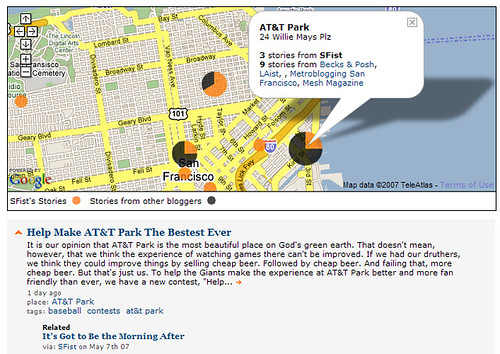You may not have heard about it, but it's really, really cool.
At Where 2.0 in 2007, Steven Johnson showed off new features on his local news and blog start-up Outside.in. The site initially launched with a blog post driven look at neighborhoods, but now more map-centric features have been added that provide some informing views. It is a great demonstration of why bloggers (and blogging platforms) should start geotagging their content.
The site now has a map that shows the most recent locations that a blog has covered. The blogmap shown below is for BlogChelsea. When you hover over one of the circles a balloon shows what other bloggers and news sites have also covered that same location recently. The size of the circle reflects the number of articles and posts.
They have also created a data visualization for Brooklyn that shows seven months of news stories and posts in Brooklyn. In the time-lapse animation you can see bloggers sticking with a story much longer than traditional news sources. It's interesting to watch the mainstream press report on something and then never really come back to it, while the people who are there keep the topic going.
This is the only map on the site like it; I hope that they find a way to automate it for all neighborhoods. Topix has been doing a lot of news coverage for neighborhoods. I wonder how their data would affect these maps; I think that the mainstream press would disappear and that there would be more stories on the map.
The stories seen on Outside.in come from about 2000 bloggers in 3255 neighborhoods in 59 cities (all of these numbers will be expanding in time). They recently just announced America's 10 "bloggiest" neighborhoods from these cities (the larger metropolitan areas of the US). The bloggier neighborhoods are disproportionally ones that are gentrified.
Steven also dived into some of the core methods for pulling in locations from a blog post. They try to be very loose on what they accept and strict with what they output. They accept many different location inputs, as Steven sent me in email:
The primary unit is the post. Posts are tagged by default with the zip codes associated with the blogger, but they will get routed to different neighborhoods (or specific addresses and places) based on a number of different criteria: internal where tags, zip code tags, GMAP links, GEORSS, our own taggers attaching it to a new location, users attaching it to a new location, etc.
Outside.in is among the many sites that now outputs GeoRSS. Sadly, these feeds do not show up in the geoindex yet (though they are in the yellow pages as reviews).
Even though the inputs and outputs are generally lat/long, the site is organized geographically by neighborhood. The neighborhoods were created by the Outside.in team. One of their guiding principles is that neighborhoods are human-scale.
Steven also spoke about his book The Ghost Map and how it inspired Outside.in. The book covers the infamous cholera outbreak of London in the 19th century. The outbreak was stopped by two men (Whitehead and Snow) who used their social network to create a map of the cholera deaths. Through this work they identified an infected water pump and saved many lives. If you want to learn more quickly here's a video of Steven talking about Ghost Map.
Snow and Whitehead would not have been able to actually solve the mystery if the following circumstances hadn't occurred:
- Open data archives - They had access to the local death records and were able to create a "Victorian Mashup".
- Density - London and its neighborhoods were dense. This density allowed the disease to spread. The density also allowed a pattern to emerge that ultimately led to stopping the pandemic.
- Local Amateurs - Snow was a physician and an amateur cartographer. Whitehead was a local vicar, but he knew everyone. Many bloggers are today's local amateurs.
- Pattern Recognition - Plotting the data on the map was obviously key. Without it they would not have been able to center in on that single pump.
Today neighborhoods are still dense and geodata is becoming available (see GeoCommons for an example), but it is difficult to know who else is talking in your area. This realization is what led to the creation of Outside.in, a place for local amateurs to connect and potentially enable future Snow's & Whitehead's.
Outside.in has a good start on this goal. They are building the framework of the site to fill out in the future with more data. As they start to aggregate more sources and expand to more cities they will start to become a valuable resource to locals and tourists.
---------
Outside.in puts neighborhood news on the map
June 7, 2007
Brady at O’Reilly Radar has a great post on Outside.in. The startup aggregates local blogs, organizes them by neighborhood and plots them on a map.
I’ve written before about the importance of being hyperlocal. If I were running a media outlet, every story, photo and video would have geographic metadata. Outside.in shows what’s possible once the data is in place.
Among the things you can do:
- See where things are happening
- Subscribe to a feed of your neighorhood
- Discover blogs about your neighborhood
- Discover and interact with your neighbors
Outside.in has a great visualization comparing blogger vs. mainstream media coverage of local stories. Not surprisingly, bloggers tend to stay on stories longer. While many stories start in MSM, a good number only exist in blogs.
Outside.in provides an interesting contrast to Topix, a local news site that focuses on “official” sources. So far, I’m finding that Outside.in has a much more local feel than Topix because of the wider range of sources. (One of my recommendations for Topix was to leverage local bloggers.)
Right now there’s a lot of clutter in the results, because there isn’t a lot of geo-tagged content in blogs. Outside.in is making guesses based on where the blogger is based, ZIP codes, links to maps and other indicators of location.
As GeoRSS gets more widely adopted, the results should be much cleaner. Platforms like WordPress don’t easily offer ways to geotag their content. Although I don’t often blog about local issues, it would be nice to have the ability to tag the posts that have a local component.














No comments:
Post a Comment